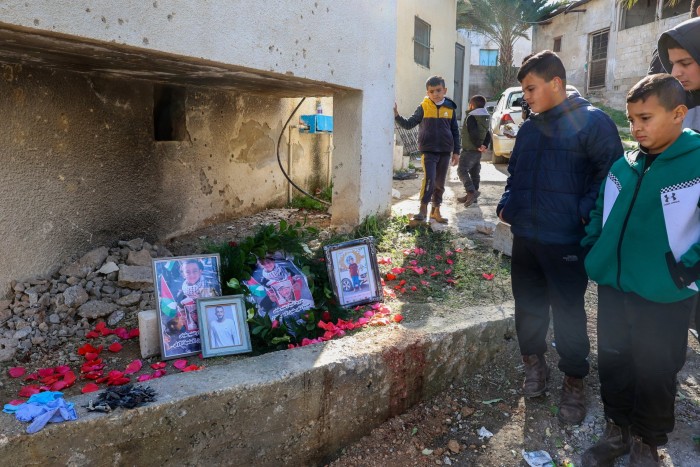Inside Israel’s ‘Gazafication’ of the West Bank

The initial report from Israel’s military was brief and unequivocal. “The [Israeli air force] struck a terrorist cell in the area of Tammun. Details to follow.”
It was also wrong. In fact, the drone strike in the hillside town in the north of the occupied West Bank had killed three Palestinian cousins, aged eight, 10 and 23, as they gathered on the sloping street just metres from Iman Bisharat’s front door.
When Bisharat rushed outside moments later she was confronted with a scene of total horror. Her son Hamza’s body was riddled with shrapnel. His cousin Reda’s head had been cut open and part of his brain was spilling out. The third cousin, Adam, drew his final breaths in her arms.
“There was a huge boom, like the whole sky was exploding . . . there was shrapnel everywhere,” she said. “The blood . . . everything I saw. It was like a scene from Gaza in front of me.”
The strike on January 8 — which the Israeli army said had been investigated and sent to the military advocate general for review — was part of a broader escalation by Israeli Prime Minister Benjamin Netanyahu’s government that has sent the Palestinian death toll in the West Bank spiralling to its highest level in two decades.
Although the level of force Israel is using in the territory is not comparable to the devastation it has unleashed in Gaza in response to Hamas’s attack on October 7 2023, over the past 18 months the Israeli military has dramatically intensified its operations in the West Bank as well.
In the process, it has increasingly deployed tactics and weaponry that it has frequently used in Gaza but which have not been seen in the West Bank for years — prompting human rights watchdogs and aid groups to warn of a “Gazafication” of Israeli operations in the territory.
After a 17-year pause, the military has resumed air strikes in the West Bank, carrying out dozens of attacks using drones, but also helicopter gunships and — in at least one case — a fighter jet. And earlier this year, it deployed tanks there for the first time in more than 20 years, as it launched an operation against militants in refugee camps in Jenin, Tulkarem and Nur Shams.
The new approach adopted by Netanyahu’s government — widely seen as the most right-wing in Israeli history — has taken a heavy toll. According to the UN’s humanitarian arm OCHA, Israeli forces have killed more than 900 people in the West Bank since October 7, making 2023 and 2024 the deadliest years for Palestinians there since the UN began collecting data in 2005. In the same period, Palestinians in the territory have killed 32 Israelis.
But the casualty figures are only part of the story. The Israeli operation has also destroyed infrastructure, with forces tearing up roads and demolishing houses, and displaced tens of thousands of people. And it has been accompanied by sweeping restrictions in movement and suffocating economic pressure that have upended daily life for the West Bank’s 3.3mn Palestinians.
“What the Israelis are looking for is submission,” said Diana Buttu, a lawyer and former adviser to Palestinian president Mahmoud Abbas. “All of this is a mechanism to send a message to Palestinians that they require unconditional surrender.”
Israeli officials say that the campaign in the West Bank is needed to root out militants from areas where the Palestinian Authority — which exercises limited self-governance in parts of the territory — has lost control.
The military said its use of air strikes — which resumed in June 2023, but escalated massively after October 7 — was a response to the “growing threat” the militants posed, reflected in the intensity of their confrontations with Israeli forces, and complied with international law.
Michael Milshtein, a former IDF intelligence officer, said that in addition to being a response to militants’ greater use of weapons such as improvised explosive devices, the shift in approach was also part of a broader change in thinking in Israeli security circles after October 7.
“It’s a lesson many people learned: you cannot let any challenge or threat [develop]. Immediately when you identify it, you need to take a tough and very strong response,” he said.
But others say the increased use of force is being driven by Israeli politics. Netanyahu’s coalition depends on the support of two far-right groups led by ultranationalist settlers Bezalel Smotrich and Itamar Ben-Gvir, who are bent on annexing the West Bank, and have repeatedly demanded that Netanyahu adopt a more aggressive approach in the territory.
The new campaign in the West Bank was launched just two days after the government agreed to a temporary ceasefire in Gaza in January — something Ben-Gvir and Smotrich had bitterly opposed.
“Some of the factors are operational, but there are also political optics to it,” said Ibrahim Dalalsha, director of the Horizon Center for Political Studies in Ramallah. “The use of an F-16 against Tulkarem camp was not only for operational reasons, because they could have used a drone . . . It was like using a cannon to kill a fly.”
Indeed, human rights groups regard Israel’s actions in the West Bank as disproportionate. Last month, the UN’s human rights office accused it of showing “an alarming disregard for Palestinian lives” and carrying out “unlawful killings” in the territory, arguing that its actions there could not be justified under the applicable legal framework.
“As there are no hostilities in the West Bank, the international human rights law standards on the use of force in law enforcement operations apply,” it said in a statement. “Instead, Israel now routinely resorts to using tactics and weapons developed for war fighting, including the deployment of air strikes and tanks.”
“Air strikes and this practice of displacing whole communities and destroying the infrastructure they depend upon — the refugee camps, the roads — this is prohibited in law enforcement operations in occupied territory,” said Eitan Diamond, manager and senior legal expert at the Diakonia International Humanitarian Law Centre in Jerusalem.

But it is not just the military’s greater use of force that has transformed life in the West Bank. Since October 7, the military has also set up dozens of new barriers and roadblocks across the territory, bringing the number of “movement obstacles” to more than 800, according to OCHA, and turning once short journeys into hours-long, unpredictable odysseys.
Meanwhile, violence by Jewish settlers in the West Bank has surged. According to OCHA, since October 7, settlers have carried out more than 2,200 attacks on Palestinians that resulted in casualties or damage to property, disrupting the olive harvest, damaging livelihoods, and forcing the displacement of dozens of Bedouin and herding communities.
Activists estimate that settler violence, settlement expansion, access restrictions and land seizures have cut Palestinians off from hundreds of thousands of dunams of their land since October 7.
For locals such as Bisharat, the combination has been overwhelming. Before the war, she used to go on day trips to Nablus, one of the main cities in the north of the West Bank that lies just 20km from Tammun. But now, she does not dare. The risks — of being attacked by settlers, encountering the army, or being held for hours at a checkpoint — are just too great.
“Anything unpredictable can be a disaster. Every time we leave home, even if it’s just to go and buy something, it’s like a big risk where God knows what will happen,” she said.
“But the problem is that now you have this fear even when you are at home . . . if they got away with killing our kids, with no reason, they can get away with anything else.”
Cartography by Steve Bernard, data visualisation by Aditi Bhandari










